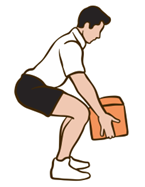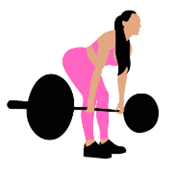by: Morgan Dickey
WHAT IS FUNCTIONAL TRAINING?
Many individuals get fearful about exercising due to injury, feeling awkward, or perceiving that the exercises they are doing are pointless. Functional training is a way to incorporate exercising in the gym to correlate back to activities of daily living. Each body is meant to push, pull, rotate, squat, lunge, and bend. Whether you do these movements everyday, or you never do them, it is important to work out intentionally and consistently.
Each body is meant to push, pull, rotate, squat, lunge, and bend. Whether you do these movements everyday, or you never do them, it is important to work out intentionally and consistently.
THREE BENEFITS OF FUNCTIONAL TRAINING:
- IT HELPS WITH EVERYDAY ACTIVITIES
Functional training directly correlates back to our everyday activities. For example, a n individual does a squat every time they get in and out of a chair and training for that can make those movements easier and reduce risk of injury.
n individual does a squat every time they get in and out of a chair and training for that can make those movements easier and reduce risk of injury.
2. REDUCES THE RISK OF INJURY
When there is a heavy amazon box on the front porch, many people will lift it without bracing themselves and may hurt their back. If you notice the two photos, the same movement between a deadlift and carrying a heavy box. Functional training is ensuring you know to have a straight back, chest upright, and knees bent to reduce the risk of injury.
3. IMPROVEMENTS IN BALANCE, MOBILITY, PROPRIOCEPTION AND CORE STABILITY
Current research is showing that functional training shows improved function of the kinetic chain, improving balance, mobility, proprioception and core stability. (Beckham, 2010)
WHAT DOES A FUNCTIONAL TRAINING WORKOUT LOOK LIKE?
For most beginners, 12 repetitions and 1-2 sets is sufficient for a functional training workout. (Mahaffey, n.d.) Some ideas for workouts include:
| ● Squats | ● Lunges | ● Push-ups | ● Deadlifts |
All of these can be used with household items like books, canned goods, or plastic water bottles. Functional training has to be functional for YOU! So even if that looks like bicep curls with canned corn, you’re moving and strengthening your muscles!
References:
Beckham, Susan G. Ph.D., FACSM, RCEP, CSCS; Harper, Michael M.Ed.. FUNCTIONAL TRAINING: Fad or Here to Stay?. ACSM’s Health & Fitness Journal 14(6):p 24-30, November 2010. | DOI: 10.1249/FIT.0b013e3181f8b3b7
Mahaffey, K. (n.d.). Functional training: Compound workouts for fitness. NASM. https://blog.nasm.org/functional-training-compound-workouts
Basics of strength and Conditioning Manual. (n.d.). https://www.nsca.com/contentassets/116c55d64e1343d2b264e05aaf158a91/basics_of_strength_and_conditioning_manual.pdf